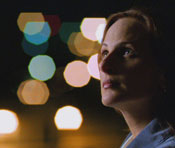What’s So Bleeping Funny?!
We filmmakers aren’t strangers to the concept of using humor as “comic relief”. Editing a funny scene after a particularly difficult scene allows the viewer a moment of respite, to regain their bearings.
For example, In Rick Trank’s documentary “I Have Never Forgotten You”, about the life and legacy of the famed Nazi hunter and humanitarian Simon Wiesenthal, Rick provided much needed comic relief by using Simon’s quirkiness as well as his fondness for joke-telling to relieve the trauma of scenes about the Holocaust.
Many other celebrated documentary filmmakers, including Michael Moore and Morgan Spurlock, have mastered the art of comic relief.
But what about using humor in an entirely different way, not to relieve pain, but to invite learning? I recently came across this concept from the producers of the hybrid documentary “What the Bleep Do We Know!?”
A box office hit that caught critics by surprise, this interesting film explores the notion of changing reality with one’s mind. It creatively blends a talking-head documentary with an artfully rendered narrative. And the producers consciously used humor in an innovative way: to increase the brain’s “neuroplasticity”, i.e., ability to learn.
Banking on research that laughter and surprise increases the brain’s ability to form new neural connections, the filmmakers crafted a funny scene prior to a sequence that they knew would challenge many viewers’ ideas about the mind. I remember watching this funny, animated wedding scene with my girlfriend in a Landmark movie theater. We laughed so hard our mouths hurt.
If you’ve seen the film, you’ll recall that directly after this humorous wedding scene, the heroine, Amanda, played by actress Marlee Matlin, experiences an attack of low-self-esteem and then an epiphany of self-love.
“The (wedding) party was intended to give the audience a good laugh and a break from all the serious intellectual information,” says William Arntz, co-author of the book “What the Bleep Do You Know!?: Discovering the Endless Possibilities for Altering Your Everyday Reality”. “Swimming in neuroplasticity, the audience then rewires the brain to accept all that information, clearing the slates, so that it’s easier to accept Marlee’s experience as their own.”
It’s an interesting idea. Laughing opens your mind to learning and accepting new, out-of-the-box ideas. How can you use humor, not only as a relief from a difficult scene, but to prepare you audience for an unusually challenging concept? Look for opportunities to place a humorous scene just prior to a radical idea, and then test your structural experiment at rough cut screenings.
For a free guide on how to hold a successful Rough Cut Screening, go to:
https://newdocediting.com/client-resources/documentary_fil_rough_cut_screening/
